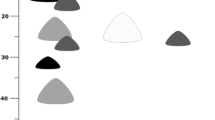Summary
In Okinawa,Ropalidia fasciata males emerge at all stages of the colony cycle and they can inseminate first brood females. These first brood females can found their own nests, lay female-destined eggs on these, or work for their natal colonies. This flexible reproductive strategy ofR. fasciata is considered to be adaptive under environmental conditions where most of colonies are destroyed by typhoons, ant predation and parasitism.
Zusammenfassung
BeiRopalidia fasciata auf Okinawa entstehen die adulten Männchen während des gesamten Koloniezyklus. Die frühzeitig entstehenden Männchen können sich mit den Erstbrutweibchen paaren. Diese Erstbrutweibchen können sowohl selbst Kolonien gründen als auch weibchendeterminierte Eier in ihre mütterlichen Nester legen oder für ihre Kolonien arbeiten. Diese flexible Strategie vonRopalidia fasciata wird als Anpassung an eine Umwelt interpretiert, in der die meisten Nester durch Taifune, räuberische Ameisen und parasitische Wespen zerstört werden.
Similar content being viewed by others
References
Evans H.E., West-Eberhard M.J., 1970.—The wasps.Univ. Michigan Press, Ann Arbor, Mich., 1970.
Itô Y., 1983.—Social behaviour of a subtropical paper wasp,Ropalidia fasciata (F.): Field observations during founding stage.J. Ethology, 1, 1–14.
Itô Y., 1985.—Colony development and social structure in a subtropical paper wasp,Ropalidia fasciata (F.) (Hymenoptera: Vespidae).Res. Popul. Ecol., 27, (in press).
Itô Y., Iwahashi O., Yamane S., Yamane Sk., 1985.—Overwintering on and re-use of nests inRopalidia fasciata (Hymenoptera: Vespidae).Kontyû, Tokyo, 53, 486–490.
Kasuya, E., 1983.—Social behaviour of early emerging males of a Japanese wasp,Polistes chinensis antennalis (Hymenoptera: Vespidae).Res. Popul. Ecol., 25, 143–149.
Nelson J.M., 1982.—External morphology ofPolistes (paper wasp) larvae in the United States.Melanderia, 38, 1–29.
Strassman J.E., 1981.—Evolutionary implications of early male and satellite production inP. exclamans colony cycles.Behav. Ecol. Sociobiol., 8, 55–64.
West-Eberhard M.J., 1969.—The social biology of polistine wasps.Univ. Mich. Mus Zool. Misc. Publ., 1–101.
Author information
Authors and Affiliations
Rights and permissions
About this article
Cite this article
Itô, Y., Yamane, S. Early male production in a subtropical paper waspRopalidia fasciata (Hymenoptera: Vespidae). Ins. Soc 32, 403–410 (1985). https://doi.org/10.1007/BF02224017
Received:
Accepted:
Issue Date:
DOI: https://doi.org/10.1007/BF02224017




